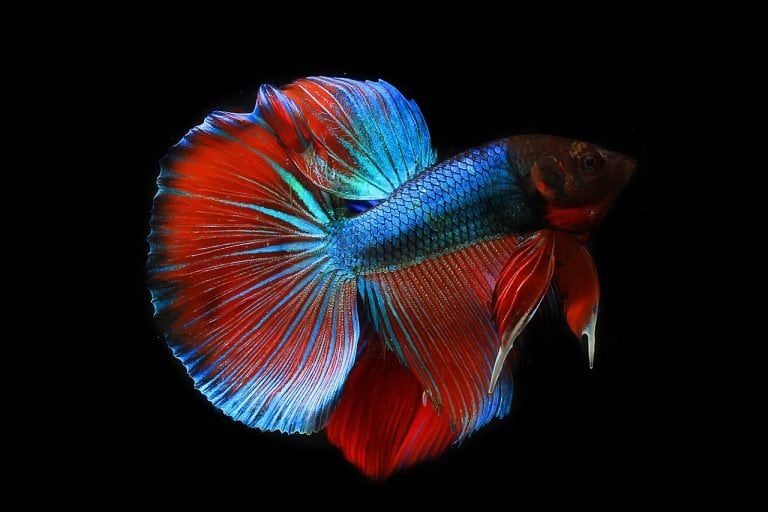In the intricate dance of aquatic existence, betta fish, with their vibrant hues and flowing fins, exhibit a behavior known as flaring, where they spread their gills and fins widely.
This intricate gesture, far from mere aesthetic display, serves as a multifaceted signal within the betta’s silent watery domain. Flaring can be understood as a form of expression that ranges from territorial assertion to a component of mating rituals, and even as an indicator of stress.
Enthusiasts who cherish the liberty inherent in the natural world must consider the implications of such behaviors in their care practices. This introduction seeks to elucidate the nuanced motivations behind betta flaring and guide caretakers in fostering environments that respect the instinctual needs of these majestic creatures, thus ensuring their well-being and freedom to display their full behavioral repertoire.
Key Takeaways
- Flaring is a distinct behavior in betta fish where they spread their gills and fins.
- Flaring serves as a territorial display to dissuade rivals or attract potential mates.
- Flaring behavior is primarily a territorial display to assert dominance and ward off rivals.
- Flaring gills can be a sign of stress in betta fish.
Understanding Betta Flaring Behavior
While betta fish are known for their vibrant colors and elegant fins, the act of flaring—where they spread their gills and fins—is a distinct behavior that serves several key functions in their natural repertoire.
Flaring frequency can be indicative of social interactions, as it is often employed as a territorial display to dissuade rivals or to attract potential mates. Betta fish, being solitary creatures, rely on this visual communication to maintain their autonomy and ensure survival.
Moreover, flaring is also believed to play a role in gill health, as the action potentially aids in dislodging debris from the gill filaments and increasing water flow over the respiratory surfaces.
This behavior underscores the intricate balance between environmental interaction and physiological necessity.
Territorial Displays in Bettas
Betta fish exhibit flaring behavior primarily as a territorial display to assert dominance and ward off potential rivals within their habitat. This dramatic expansion of the gills serves as a visual signal in fish communication, a vital component in the establishment and maintenance of territorial boundaries.
Researchers have identified specific aggression triggers that prompt such displays, including the presence of conspecifics—members of the same species—or reflections perceived as intruders. The flaring gesture is a clear, unambiguous exhibition of strength and prowess, designed to intimidate without immediate physical confrontation.
Analyzing this behavior provides insight into the intricate social structures and conflict resolution strategies of Betta fish, reflecting a complex interplay of instinctual drives for territory, mating rights, and survival.
Flaring as a Mating Signal
In addition to territorial displays, the act of gill flaring in betta fish also serves as a crucial component of their mating ritual. During courtship behavior, the male betta utilizes gill display to signal reproductive readiness and to attract a potential mate. This visual communication is both intricate and nuanced, reflecting evolutionary adaptations for species-specific mating cues.
- Visual Attraction: The male betta enhances his coloration and spreads his gills widely to showcase vigor and genetic quality to the female.
- Courtship Dance: Alongside gill flaring, the male performs an elaborate dance to entice the female, reinforcing the display with kinetic energy.
- Territorial Delineation: Flaring during courtship also serves to dissuade rival males, ensuring the male’s exclusive access to the female for mating.
Stress-Induced Flaring Responses
The display of flared gills in betta fish can also be a sign of stress, triggered by environmental factors or perceived threats. This physiological reaction is often a result of abrupt changes in their surroundings, such as fluctuations in water parameters or the introduction of new tank mates, which can disrupt gill health.
A scientific analysis of flaring frequency as a stress response is critical, as constant flaring can lead to exhaustion and compromise the immune system, making the fish more susceptible to diseases. It is essential to monitor the betta’s environment and ensure it is conducive to its well-being, thereby reducing stress-induced flaring.
Maintaining a stable habitat allows the betta the freedom to exhibit natural behaviors without the constant pressure of stress responses.
Managing Your Betta’s Environment
While providing an optimal habitat for betta fish is crucial, it is equally important to understand the specific environmental conditions that minimize stress and prevent the need for excessive gill flaring.
To maintain a conducive environment for betta fish, consider the following:
- Water Parameters: Ensure consistent water quality by monitoring pH levels, hardness, ammonia, nitrites, and nitrates. Optimal water parameters reduce stress, thus diminishing the likelihood of defensive gill flaring.
- Temperature Regulation: Betta fish thrive in a stable thermal range of 76-81°F (24-27°C). Sudden temperature fluctuations can lead to stress, prompting the flaring of gills.
- Tank Enrichment: Incorporate plants, hiding places, and ample swim space to simulate a natural ecosystem. An enriched tank environment can alleviate stress and encourage natural behavior over territorial displays like gill flaring.





